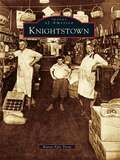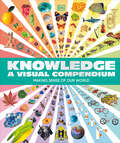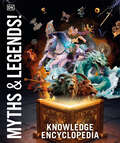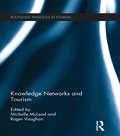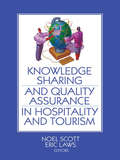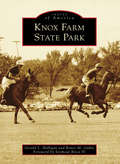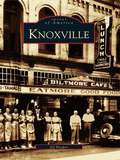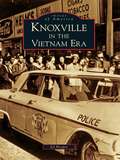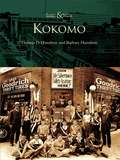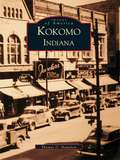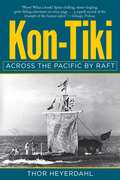- Table View
- List View
Knightstown (Images of America)
by Karen Pyle TrentLike many other communities along the 824-mile Historic National Road, Knightstown owes its existence to the paving of this remarkable roadway. When it became evident that the new road would cut across his Henry County, Indiana, farm, early settler Waitstill Munson Cary hired national road surveyor Jonathan Knight in 1827 to plat the tiny town and then named the community after Knight. Over the years, Knightstown's prosperity in many ways has paralleled the ups and downs of travel and transportation along the Historic National Road, also known as U.S. Highway 40. This collection of vintage images traces Knightstown's journey from a settlement on the west bank of the Big Blue River to a close-knit community bound by family and priding itself on a history of education, architecture, and of course, Hoosier basketball.
Knitlandia: A Knitter Sees the World
by Clara ParkesThe renowned knitter and author of The Yarn Whisperer spins tales of a creative life enriched by world travel in this New York Times–bestselling memoir.In Knitlandia, Parkes invite readers and devoted crafters on excursions to be savored, through seventeen of her most memorable journeys across the globe. Her knitting adventures span from the fjords of Iceland to a cozy yarn shop in Paris’s thirteenth arrondissement.Also known for her PBS television appearances and hugely popular line of small-batch handcrafted yarns, Parkes weaves her personal blend of wisdom and humor into this eloquently volume that is part personal travel narrative and part cultural history, touching the heart of what it means to live creatively.
Knitting California: 26 Easy-to-Follow Designs for Beautiful Beanies Inspired by the Golden State
by Nancy BatesEureka! From the sea life of Monterey and the surfing culture of SoCal, to the glamour of Hollywood and the majesty of the Coastal Redwoods, California has some of the most unique and diverse landscapes in the United States. Capture the history, spectacular scenery, and fascinating landmarks California offers with original beanie patterns created by knitting designer, author, and proud Californian, Nancy Bates. The 26 beanie patterns in this book range from simple beanie constructions depicting the gold rush or the Golden Gate Bridge, to more challenging stitch patterns such as the Forests of the North. From wine country to orange groves, gray whales to monarch butterflies, and everything in-between, the beauty of California is depicted in these charming beanies. Clear charts, easy-to-read keys, and thorough instructions help any knitter, whether beginner or experienced, through these gratifying projects. Show your love for California with these beautiful beanie designs you can wear any time and any place. 26 BEANIE PATTERNS: Including both simple and more challenging stitch patterns, there is something for everyone with these 26 beanie patterns INSPIRED BY THE BEAUTY OF CALIFORNIA: From the state flag to the beautiful Big Sur coastline, each beanie pattern celebrates the beauty of California THE PERFECT GIFT: Perfect for any knitting enthusiast, this book is the gift that keeps on giving with the beanies also being great gifts for fans of Californi SPECTACULARLY PHOTOGRAPHED: Each pattern is accompanied by photos of the finished beanie and California's landscapes, landmarks, flora, and fauna EASY-TO-FOLLOW INSTRUCTIONS: Each of the 26 beanie knitting patterns has been tested and offers clear charts so that knitters of every skill level can knit a beanie in no time.
Knitting the National Parks: 63 Easy-to-Follow Designs for Beautiful Beanies Inspired by the US National Parks
by Nancy BatesFrom the brightly colored pebbles of Lake McDonald in Montana&’s Glacier National Park to the regal granite cliffs of El Capitan and Half Dome in California&’s Yosemite Valley, the US National Parks contain some of the most recognizable and iconic natural landmarks in the world. Capture the majesty each national park offers with original beanie patterns created by knitting designer and outdoor enthusiast Nancy Bates. Beanies range from simple beanie constructions to more challenging stitch patterns such as the two-color crossovers inspired by South Dakota&’s Badlands or the multiple cable designs inspired by New Mexico&’s Carlsbad Caverns. Clear charts, easy-to-read keys, and thorough instructions help any knitter, whether beginner or experienced, through these gratifying projects. Show your love and appreciation of our national parks with these beautiful and practical beanie projects you can wear any time or any place. 63 KNITTING PATTERNS: Every US National Park is celebrated with a unique beanie design, including the newly designated park New River Gorge in West Virginia BEAUTIFULLY PHOTOGRAPHED: Each pattern is accompanied by photos of the finished beanie and gorgeous images of the park&’s landscapes that inspired it INSPIRED BY NATURE: Learn about each national park&’s unique fauna, flora, and landscapes that inspired each original beanie, from the Painted Wall in Colorado&’s Black Canyon of the Gunnison to the Salt Flats in California Death Valley EASY-TO-FOLLOW INSTRUCTIONS: Each of the 63 beanies knitting patterns have been tested and verified and offer clear charts so that knitters of every skill level can knit a beanie in no time.
Knives on the Cutting Edge: The Great Chefs' Dining Revolution
by Bob MacdonaldA respectful yet unvarnished tribute to the greatest chefs in Europe and the United States who over the last two decades have led a revolution unlike any in the history of dining.<P><P>Knives on the Cutting Edge is a culinary pilgrimage that examines the several current and important megatrends such as the rise of celebrity chefs, the healthy eating movement, and the growing emergence of bolder flavors in gourmet foods. Through visits to many of the world's greatest restaurants, Bob Macdonald provides anecdotes, personal insights, and memories that demystify the dining experience and make ordering wine at a restaurant an enjoyable hobby rather than a formidable ordeal.
Knowledge A Visual Compendium: Making Sense of our World
by DKEver wondered how many moons there are in our solar system, or the number of Olympic sports, or who the 46 US presidents were? If so, this is the book for you!Leaf through the pages of this beautiful book and you’ll find an intriguing array of objects, animals, lists, and artifacts from nature, science, technology, the arts, and history, which illustrate how we order, understand, and make sense of the world. Discover the 40 orders of birds, the 13 levels of the Beaufort Wind Scale, the 88 constellations, the 36 Morse Code symbols, the 206 bones in the human body, and much more!With its combination of attractive, timeless images and expert, engaging text, The Knowledge Compendium Book is perfect for children (and adults!) who are curious about the world and the lists, systems, and categories that help us understand it.
Knowledge Encyclopedia Myths and Legends
by DKDK’s best-selling illustrated encyclopedia series explores the fantastical world of myths and legends.Discover stories from myth and legend as you've never seen them before through incredibly detailed 3D illustrations in this encyclopedia for children aged 9+.Knowledge Encyclopedia’s clear explanations, illustrations, photographs, and 3D images will engage children in complex subjects. Find yourself transported to a realm of myth and legend with this perfect gift for anyone who loves stories of gods, monsters, and heroes.This all-encompassing myth encyclopedia for kids offers:An impressive collection of facts, charts, timelines, and illustrations.A visual approach using illustrations, photographs, and extremely detailed 3D CGI images.Clear explanations and retellings of different myths and legends from around the world.Children can explore mythology in a new and exciting way through spectacular computer-generated images of key heroes, gods, monsters, and locations. This new book in the Knowledge Encyclopedia series will inspire children with vivid depictions of scenes from the stories, and their retellings and explanations of the myths.Bringing tales from mythology and folklore to life, Knowledge Encyclopedia: Myths and Legends! lets children peer inside legendary buildings such as the Slavic Baba Yaga’s chicken-legged hut, and get up close to their favorite animal heroes, from China’s irrepressible Monkey King to West Africa’s spider trickster Anansi.More in the seriesKnowledge Encyclopedia Myths and Legends! is part of DK’s visual and hugely successful Knowledge Encyclopedia series. Complete the collection and dive into the deep with Knowledge Encyclopedia Ocean!, take a trip to the solar system with Knowledge Encyclopedia Space!, and travel back to prehistoric times with Knowledge Encyclopedia Dinosaur!
Knowledge Networks and Tourism (Routledge Advances in Tourism)
by Roger Vaughan Michelle McLeodThe receipt of knowledge is a key ingredient by which the tourism sector can adjust and adapt to its dynamic environment. However although its importance has long been recognised the fragmentation within the sector, largely as a result of it being comprised of small and medium sized businesses, makes understanding knowledge management challenging. This book applies knowledge management and social network theories to the business of tourism to shed light on successful operations of tourism knowledge networks. It contributes specifically to understanding a network perspective of the tourism sector, the information needs of tourism businesses, social network dynamics of tourism business operation, knowledge flows within the tourism sector and the transformation of the tourism sector through knowledge networks. Social Network Analysis is applied to fully explore the growth and maintenance of tourism knowledge networks and the relationships between tourism sector stakeholders in relation to their knowledge requirements. Knowledge Networks and Tourism will be valuable reading for all those interested in successful operations of tourism knowledge networks.
Knowledge Sharing and Quality Assurance in Hospitality and Tourism
by Eric Laws Noel ScottLearn both theory and practice of knowledge managementSir Francis Bacon once wrote, "Knowledge is power." Knowledge Sharing and Quality Assurance in Hospitality and Tourism provides strategies to grab that power and the competitive edge in the tourism industry through knowledge management (KM) and quality assurance. Leading tourism and hospitality experts offer the latest theory and practical frameworks to expand the knowledge needed for creating and maintaining success at destinations around the world. Each cogent chapter provides fresh directions for future research and the creation of effective ways to share and use knowledge.As the tourism and hospitality industry expands, the competition increases as the search continues for ways to ensure quality, know the consumer, and discover the best standards of destination operation. Knowledge Sharing and Quality Assurance in Hospitality and Tourism is a unique foundational text that clearly explains the theory and practical management of knowledge in this lucrative, very competitive industry. Knowledge theory is used to explore organizational functioning, change issues, and operations at destinations in industry clusters and networks. Chapters are extensively referenced. Topics in Knowledge Sharing and Quality Assurance in Hospitality and Tourism include: the role of higher education in transferring knowledge into practice four kinds of benchmarking e-mail response quality quality management at the destination level and its path to knowledge sharing tourism managers knowledge needs-the knowledge type, where the knowledge is available, and sharing that knowledge between academics and the industry strategic planning in knowledge management three element framework of knowledge management assessment a case study of an international tourism project and the use of knowledge management a case study of best practice in tourism research dissemination in Quebec and QueenslandKnowledge Sharing and Quality Assurance in Hospitality and Tourism is crucial, idea-sparking reading perfect for tourism researchers, tourism managers, administrators, educators, and students.
Knox Farm State Park
by Renee M. Oubre Gerald L. HalliganA stone wall along Seneca Street in East Aurora, New York, welcomes visitors to Knox Farm State Park with its charming buildings, woodlands, and open fields. The farmland was purchased by Seymour H. Knox, an entrepreneur from Russell, New York. Successful in the five-and-dime store industry with his cousin F.W. Woolworth, Knox expanded his business interests to include raising horses and developing a self-sustaining farm. Following his death in 1915, his family maintained and expanded the property, gracing it with architectural features reflecting their interests. In the 1990s, with the passing of Seymour Knox II and sons, the family's desire to preserve the beloved property was fulfilled with the establishment of Knox Farm State Park.
Knoxville (Images of America)
by Ed HooperThough it began as a small fort on the Tennessee River, Knoxville would not know obscurity for long. Founded in 1791, Knoxville became the capital of the new state of Tennessee five years later and rapidly became a major metropolitan area for the southeastern United States. Exportations of raw and natural goods brought wealth and new residents, and soon its main thoroughfare became a window into the growth, development, decline, and rebirth of an all-American city. Then, as now, all roads downtown lead to Gay Street, and everything Knoxville came from it.Though Knoxville is a decidedly Southern city, it has also taken its place within the American melting pot. Swiss, English, Dutch, Irish, German, Greek, African, and Spanish families have all played major roles in the city's development. For many years, at one small popcorn stand on Gay Street stood Gary Crowder-the meticulous owner of the amazing collection of photographs predominantly featured in Images of America: Knoxville.
Knoxville in the Vietnam Era (Images of America)
by William Edward HooperThe Vietnam War era (1961-1975), one of our country's most turbulent periods, was also a time of change and social evolution. Seeded in the aftermath of World War II, the nation enjoyed a remarkable economic boom. Knoxville and East Tennessee stood witness to the transformation of American society and the problems that came with the new success. From the first recognized combat casualty of the Vietnam War to the evacuation of Saigon, Knoxvillians were there, and their stories of sacrifice and service earned little mention or were forgotten in historical texts. At home, urban decay gained a grip on Knoxville's once vibrant downtown, and protests were not an uncommon sight on the evening news, but there was progress too. This volume documents the start of a new beginning for Knoxville as the city tried to hold onto its traditional Appalachian values and move into a new era.
Kokomo
by Barbara Hamilton Thomas D. HamiltonAs we move out of the past and into the present, our landscape is forever altered by the passing of time. The face of Kokomo, "The City of Firsts," has changed over the years. Once an image of small-town Americana, Kokomo has grown-expanding its industrial reach, enticing new residents, and continuing to be the first in a number of fields.Kokomo, Indiana: Then and Now takes the reader back to a simpler time in Kokomo history. Using historic images paired with contemporary photos, authors Thomas D. and Barbara Hamilton have created a charming view of the area's history and evolution.
Kokomo, Indiana (Images of America)
by Thomas D. HamiltonAccording to legend, Kokomo, Indiana was named after a Miami Indian Chief who lived in the area, "Ma Ko Ko Mo" -meaning Black Walnut. Founded in 1842 by David Foster, a frontier trader, Kokomo has since become the home to many of the nation's most influential inventions. From the birthplace of the automobile to the introduction of stainless steel and the development of canned tomato juice, Kokomo has been a leader in ingenuity, earning its nickname, the "City of Firsts." In this collection of reminiscent images, Kokomo, Indiana illustrates the charming history of an area which has developed from a small community to what is now one of the largest cities in Indiana. The book is an exploration of the city's streets and a stroll through the history of its growing neighborhoods, tracing the fascinating past of a bygone age.
Kokoro: Japanese Wisdom for a Life Well Lived
by Beth Kemptonkokoro [n.] intelligent heart, feeling mind One year. Two devastating losses. Three sacred Japanese mountains. A major life transition, a heart full of grief and a revelation that changes everything. Join Japanologist Beth Kempton on a pilgrimage through rural Japan in search of answers to some of life's biggest questions: How do we find calm in the chaos and beauty in the darkness? How do we let go of the past and stop worrying about the future? What can an awareness of impermanence teach us about living well?Together you will journey to the deep north of Japan, hike ancient forests, watch the moon rise over mountains of myth and encounter a host of wise teachers along the way - Noh actors, chefs, taxi drivers, coffee shop owners, poets, philosophers and the spirits that inhabit the land. You will contemplate the true nature of time at one of the world's strictest Zen temples and nothing will be quite the same again.This book is an invitation to cultivate stillness and contentment in an ever-changing, uncertain world. It all begins with the kokoro, a profound Japanese term which represents the intelligent heart, the feeling mind and the embodied spirit of every human being.To explore the kokoro is to explore the very essence of what it means to be human in this tough yet devastatingly beautiful world. When you learn to live guided by the light in your kokoro, everything changes, and anything is possible.
Kokoro: Japanese Wisdom for a Life Well Lived
by Beth KemptonThis book invites you to cultivate stillness and contentment in an ever-changing, uncertain world, inspired by ancient and contemporary Japanese wisdom. Drawing on a thousand years of Japanese literature, culture, and philosophical ideas to explore the true nature of time and what it means to be human, Kokoro–which mysteriously translates as "heart-mind"–is a meditation on living well. Join Japanologist Beth Kempton on this life-changing pilgrimage far beyond the tourist trail, to uncover the soul of the country, its people, and its deeply buried wisdom. Distilling insight from a rich variety of sources, from centuries-old poetry and ancient Zen texts to martial arts teaching and contemporary philosophy, alongside the real-life stories of modern day pioneers, Kokoro offers an inspiring take on what it truly means to be happy,so that you can live each day with wonder and ease.
Kon-Tiki
by Thor Heyerdahl Steven Callahan"One of the great adventures of our time." -Life"Am going to cross Pacific on a wooden raft to support a theory that the South Sea islands were peopled from Peru. Will you come? . . . Reply at once." That is how six brave and inquisitive men came to seek a dangerous path to test a scientific theory. On a primitive raft made of forty-foot balsa logs and named "Kon-Tiki" in honor of a legendary sun king, Thor Heyerdahl and five companions deliberately risked their lives to show that the ancient Peruvians could have made the 4,300-mile voyage to the Polynesian islands on a similar craft.For three months, the bold young men made their way across the pacific at the complete mercy of the ocean. They encountered storms that threatened to tear their raft apart, whales large enough to sink them in the blink of an eye, and sharks ready to feast on any man unfortunate enough to fall overboard. In the true spirit of adventure, they held on until finally making landfall on a remote Polynesian island, proving Heyerdahl's theory possible after all.On every page of this true chronicle-from the actual building of the raft through all the dangerous and comic adventures on the sea, to the spectacular crash landing and the native islanders' hula dances-each reader will find a wholesome and spellbinding escape from the twenty-first century.
Kon-Tiki: Across The Pacific By Raft (Enriched Classics)
by Thor HeyerdahlNow a major motion picture, Kon-Tiki is the record of Thor Heyerdahl’s astonishing three-month voyage across the Pacific.Kon-Tiki is the record of an astonishing adventure -- a journey of 4,300 nautical miles across the Pacific Ocean by raft. Intrigued by Polynesian folklore, biologist Thor Heyerdahl suspected that the South Sea Islands had been settled by an ancient race from thousands of miles to the east, led by a mythical hero, Kon-Tiki. He decided to prove his theory by duplicating the legendary voyage.On April 28, 1947, Heyerdahl and five other adventurers sailed from Peru on a balsa log raft. After three months on the open sea, encountering raging storms, whales, and sharks, they sighted land -- the Polynesian island of Puka Puka.Translated into sixty-five languages, Kon-Tiki is a classic, inspiring tale of daring and courage -- a magnificent saga of men against the sea.Washington Square Press' Enriched Classics present the great works of world literature enhanced for the contemporary reader. This edition of Kon-Tiki has been prepared by an editorial committee headed by Harry Shefter, professor of English at New York University. It includes a foreword by the author, a selection of critical excerpts, notes, an index, and a unique visual essay of the voyage.
Kon-Tiki: Across the Pacific by Raft
by Thor HeyerdahlThis book recounts a groups' travels across the Pacific ocean on a raft
Korea
by Simon WinchesterIn the late 1980s, New York Times bestselling author Simon Winchester set out on foot to discover the Republic of Korea -- from its southern tip to the North Korean border -- in order to set the record straight about this enigmatic and elusive land.Fascinating for its vivid presentation of historical and geographic detail, Korea is that rare book that actually defines a nation and its people. Winchester's gift for capturing engaging characters in true, compelling stories provides us with a treasury of enchanting and informed insight on the culture, language, history, and politics of this little-known corner of Asia.With a new introduction by the author, Korea is a beautiful journey through a mysterious country and a memorable addition to the many adventures of Simon Winchester.
Korea - Culture Smart!
by James HoareCulture Smart! provides essential information on attitudes, beliefs and behavior in different countries, ensuring that you arrive at your destination aware of basic manners, common courtesies, and sensitive issues. These concise guides tell you what to expect, how to behave, and how to establish a rapport with your hosts. This inside knowledge will enable you to steer clear of embarrassing gaffes and mistakes, feel confident in unfamiliar situations, and develop trust, friendships, and successful business relationships.Culture Smart! offers illuminating insights into the culture and society of a particular country. It will help you to turn your visit-whether on business or for pleasure-into a memorable and enriching experience. Contents include* customs, values, and traditions* historical, religious, and political background* life at home* leisure, social, and cultural life* eating and drinking* do's, don'ts, and taboos* business practices* communication, spoken and unspoken"Culture Smart has come to the rescue of hapless travellers." Sunday Times Travel"... the perfect introduction to the weird, wonderful and downright odd quirks and customs of various countries." Global Travel"...full of fascinating-as well as common-sense-tips to help you avoid embarrassing faux pas." Observer"...as useful as they are entertaining." Easyjet Magazine"...offer glimpses into the psyche of a faraway world." New York Times
Korea Land of the Morning Calm
by Craig J. BrownOne hundred and twenty-five years after Korea, the Land of the Morning Calm, opened itself to the world, it remains one of the least understood of Asian countries. Craig J. Brown's photographs and text brings to life the land and people of this unusual country that looks to the future, as it maintains its links to the past. This book is a feast for those hungering to learn more about this beautiful country and its gentle people.
Korea Land of the Morning Calm
by Craig J. BrownOne hundred and twenty-five years after Korea, the Land of the Morning Calm, opened itself to the world, it remains one of the least understood of Asian countries. Craig J. Brown's photographs and text brings to life the land and people of this unusual country that looks to the future, as it maintains its links to the past. This book is a feast for those hungering to learn more about this beautiful country and its gentle people.
Korea Land of the Morning Calm
by Craig J. BrownSeveral years ago, a columnist at one of Korea's English language newspapers used the byline "Only the Morning is Calm." And while Korea is known as the Land of the Morning Calm, that columnist was right on target. From the hectic sidewalks of the cities, to skiers zipping down mountain slopes, Korea is anything but a country stuck in time. Yet, the past is not forgotten here. Elements of Shamanism persist, and Confucian tradition remains the foundation of Korean culture. If you are looking for a country that fuses a thoroughly modern mindset with a deep appreciation for tradition, Korea is the place. Now, combine a vivacious Asian culture with stunning mountain landscapes, rugged coastlines interspersed with stretches of glistening white sand beaches and cities that vibrate with energy and you've got an idea of what this unusual country is all about.
Korea Land of the Morning Calm
by Craig J. BrownThis richly photographed travel pictorial tours Korea--a place of dynamic innovation with strong traditional currents.Several years ago, a columnist at one of Korea's English language newspapers used the byline "Only the Morning is Calm." And while Korea is known as the Land of the Morning Calm, that columnist was right on target. From the hectic sidewalks of the cities, to skiers zipping down mountain slopes, Korea is anything but a country stuck in time. Yet, the past is not forgotten here. Elements of Shamanism persist, and Confucian tradition remains the foundation of Korean culture.If you are seeking to travel to or experience a country that fuses a thoroughly modern mindset with a deep appreciation for tradition, Korea is the place. Now, combine a vivacious Asian culture with stunning mountain landscapes, rugged coastlines interspersed with stretches of glistening white sand beaches and cities that vibrate with energy and you've got an idea of what this unusual country is all about.
